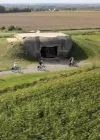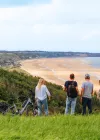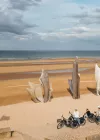Scenic Road 1944® - Best of D-Day on bike
scenic-road-1944-d-day-bike
Enjoy our all-inclusive offer on the Scenic Route 1944. A one-way tour including bike rental and return shuttle. Embark on a worry-free journey for an unforgettable day!
Discover unique landscapes, iconic historical sites along the Gold and Omaha beaches on the Vélo-maritime. From the artificial port of Arromanches to the fishing port of Grandcamp-Maisy, your route will take you, among others, through the German battery of Longue sur Mer, the small port of Port en Bessin, the American Cemetery, and Pointe du Hoc.
Book this unique experience now, blending adventure, history, and nature, for a serene day.
• Shuttle available from 3 persons
• Minimum reservation 48 hours in advance

Complete program
Departure of the ride from the Locvélo agency

Mulburry

German Battery of Longues-sur-Mer

The 47 Royal Marine Commando Memorial

Vue panoramique d'Omaha Beach

American Cemetery of Colleville-sur-Mer

Omaha Beach

Pointe du Hoc

End of the bike ride at the port of Grandcamps-Maisy
The end
Practical information
This one-day tour includes the rental of an electric-assist bicycle and return transport via van at 6 p.m.
• Departure available from 3 bookings
• Minimum reservation 48 hours in advance
Particular difficulties
Price
Budget estimé selon saison, types d'hébergements et activités. L'évolution des coûts du transport (aérien ou maritime), les choix du niveau de prestations et des périodes de voyage, le délai de réservation influent sur le prix de votre voyage.
Pour un tarif exact selon vos critères, nous pouvons vous établir un devis personnalisé.
This price includes
- The rental of an electric-assist bicycle
- The return journey by van to return to the starting point (Arromanches-les-Bains)
- The GPS track of the route and audio guidance on various points of interest
- A digital roadbook of your circuit








